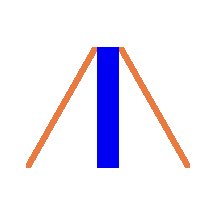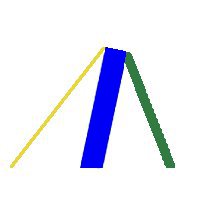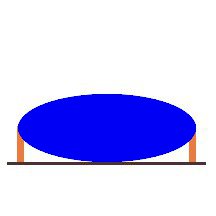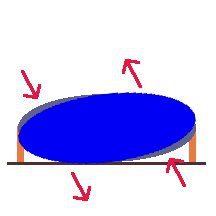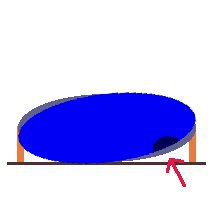| |||||||||||||||||||||
InfluencesIn the body, very often you will have pairs of opposing muscles or opposing groups of muscles -- adductors & abductors, biceps & triceps, deltoid & latissimus dorsi. In Touch for Health, they represent this with the concept of a pole with two guy wires. When the two guy wires are equal strength, they hold the pole where it belongs.
When the pole is balanced, we feel fine. When it gets unbalanced, we feel out of sorts. how it gets unbalanced can play into how to get it rebalanced. One thought is that a muscle gets overused, contracts, and develops trigger points, making that side of system too strong for the other side. It pulls the pole over. (ie the green one is causing the imbalance.) When this happens, trigger point therapy can be used to release the trigger points. Ortho-binonomy can be used to release the muscle through the nervous system. Another way balance can be lost is if one of the pairs looses it's strength and/or is overstretched. Then the 'normal' muscle operating at 'normal' strength simply pulls the pole over. (ie the yellow one is causing the imbalance.) When this happens, it's necessary to strengthen the weak muscle.
Sometimes, though, the imbalance in a body doesn't fall along the lines of muscles and bones. Sometimes it comes from an outside force and involves whatever was in the way of the vector of force. There is some similarity involved. It can be thought of as something bunched up or something stretched out. If something is bunched up, the answer is in addressing the bunched up aspect. If something has been stretched, the answer is in the stretched out aspect. Recently I have been playing with the concept of resistance in these scenarios. How is it that a vector of force moves a body? It is because the body was solid enough to be moved. There is a concept in riding called durchlassigkeit -- the quality of allowing things to move through. In riding we call it permeability, and when the horse lacks it, we call it resistance. In the martial arts, and in a lot of eastern philosophy, there is a concept of non-resistance. Whereas in the west, we often 'stand up' to something, in the martial arts and eastern philosophies I've been exposed to, there is this idea to simply get out of the way. The first thing we learned in Kuk Sool Wan was to run away! All the 'throws' were about how to get out of the way, too. (Whether you were throwing or being thrown.) Resistance led to problems. So how does this fit in? For instance, if someone were lying on a massage table and everything were 'equal,' then the two sides, left and right, would be the same distance from the table top. (In riding, I have an imaginary plane for reference, represented by the brown.)
When there is misalignment, it could be because there is push into or a pull from ... there is a vector of movement which gives direction and oomph. These are just four examples of what might be influencing an imbalance:
Or it could be there's a contraction -- which would be released by amplifying the contraction. With this idea of resistance, though, what occurs to me is that it's the solidity of the object that allows it to be moved. Yes, there's a push, a vector, but the body wouldn't move unless it was solid enough to be moved in response to it.
So I began wondering, what if that area adopted the quality of 'allowing throughness?' Could be possible to 'dissolve' the area that is being moved out of balance? What happens as this area softens and becomes receptive? I have played with this and have found to my delight that as the 'solid' resistant area dissolves, the body mass returns to equilibrium. This concept has quite a few applications -- it gets fairly 'metaphysical.' And I recall years and years ago on the Mike Douglas show who a kinesiologist demonstrated (by using muscle checking) that when you resist an 'insult' it weakens your body, but when you accept it you are strong. Cosmic. Blessings,
Lynn
Reiki Master since 1997
6/12/16
| |||||||||||||||||||||
Links
|
|||||||||||||||||||||
BooksI love books! These top three books help explain some about Resonance Repatterning® and PSYCH-KTM. I have reviews of and comments about more books with links into Amazon in my original 'Bookstore' as well as a bigger but less verbose Amazon eStore. Whenever I do online group Resonance Repatterning® series, I include books I've referenced in the resources sections for that series.
| |||||||||||||||||||||
|
© Copyright 1996-2017 satoriconnections.com. All rights reserved. |
